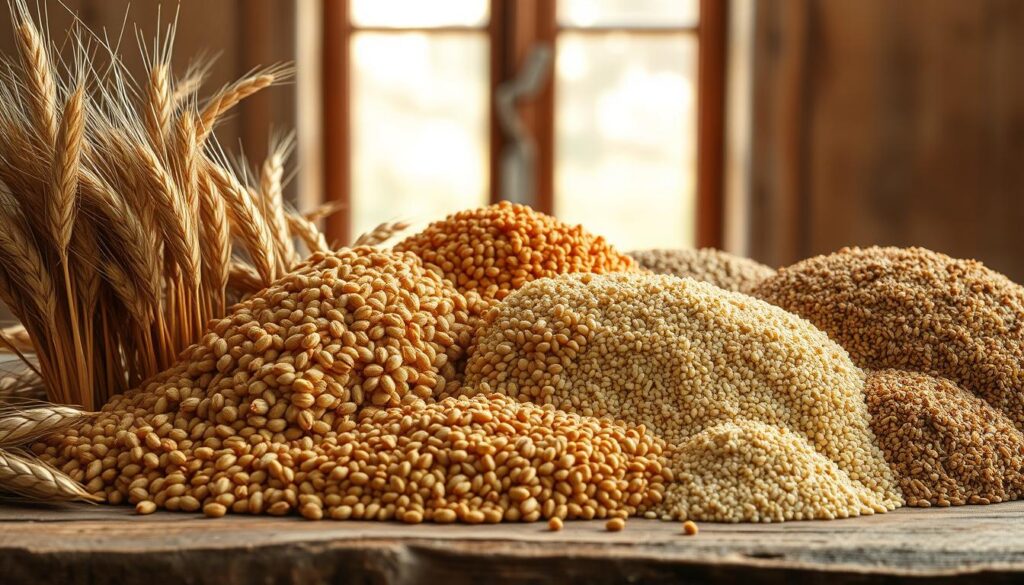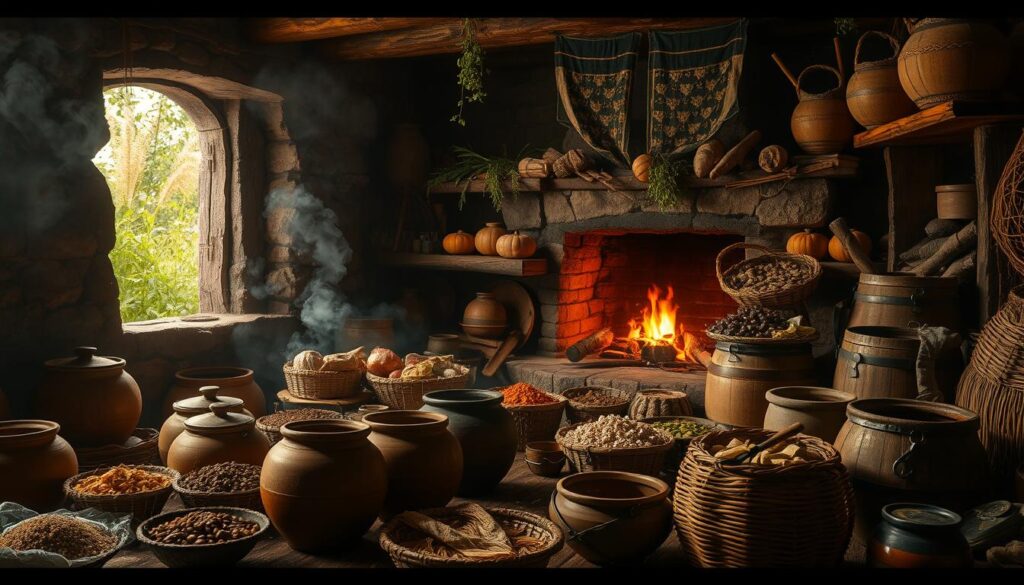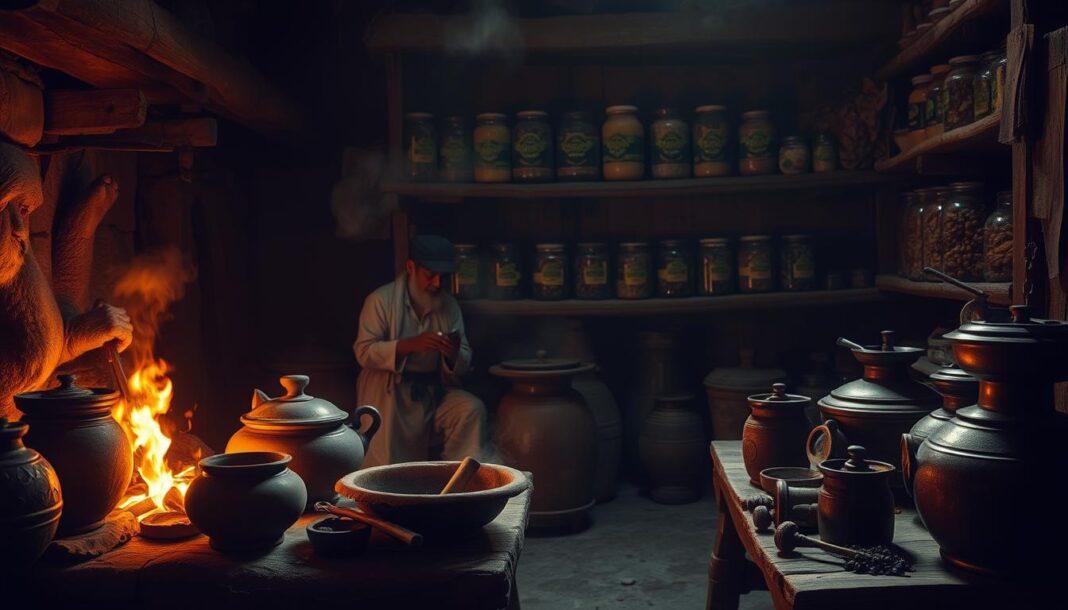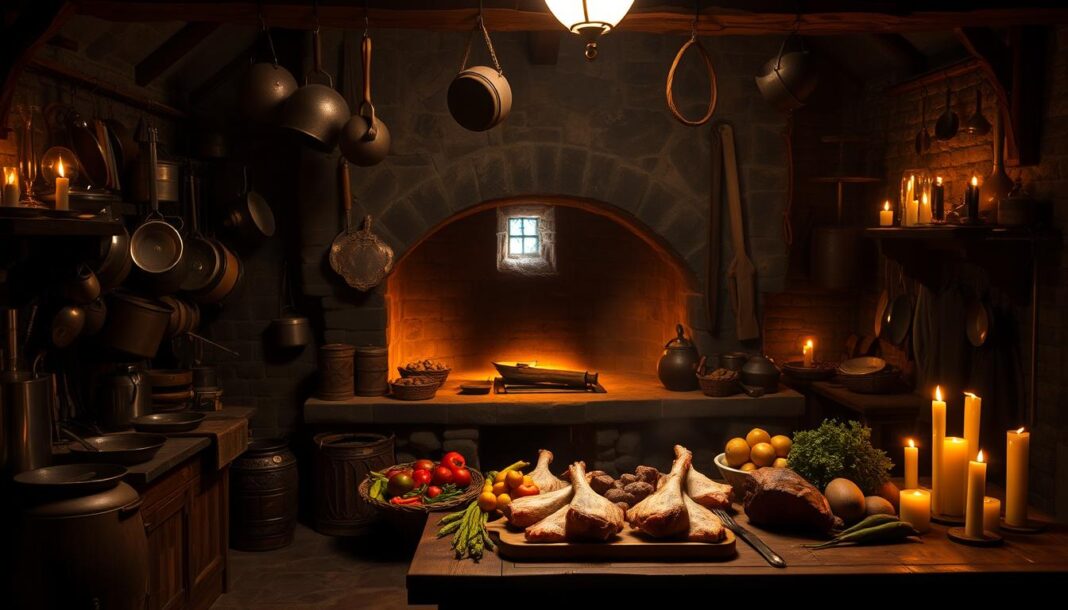We embark on a fascinating journey through the ages to uncover the science behind ancient culinary traditions that have shaped our modern understanding of food. By examining how time has influenced the evolution of recipes across different civilizations, we reveal surprising facts about nutrition that our ancestors intuitively understood.
Our exploration provides a detailed list of significant developments in food preparation techniques, from prehistoric cooking methods to sophisticated ancient cuisines. We analyze how home cooking practices have evolved while maintaining connections to ancient traditions, demonstrating the remarkable continuity in human food culture.
Key Takeaways
- Understanding the science behind ancient culinary practices.
- Exploring the evolution of recipes and cooking techniques over time.
- Discovering surprising nutritional facts known to our ancestors.
- Analyzing the continuity of home cooking practices through history.
- Appreciating the influence of past culinary traditions on modern cooking.
The Origins of Human Culinary Practices
Our culinary traditions have roots that stretch back approximately 1.8 million years, when our ancestors first harnessed the power of fire for cooking. This revolutionary transition from raw to cooked food fundamentally altered human evolution, changing our digestive systems and allowing for greater caloric intake and brain development over time.
Earliest Evidence of Cooking
The earliest evidence of cooking dates back to approximately 1.8 million years ago. Archaeological findings have revealed that early humans used primitive methods to prepare recipes through trial and error, discovering which cooking methods rendered certain food more digestible and nutritious. For instance, simple roasting over an open flame was one of the earliest forms of cooking, gradually evolving into more complex recipes. Archaeological reviews of ancient hearths and cooking implements have uncovered fascinating facts about the evolution of cooking techniques.

Transition from Foraging to Agriculture
Around 10,000 BCE, humanity underwent a significant shift from nomadic foraging to settled agriculture, revolutionizing human food systems. This transition laid the foundation for staple foods like bread and cheese, which became central to home cooking across various civilizations. As agriculture developed, so did the complexity of recipes, leading to a diverse array of culinary traditions. For more on historical recipes, you can explore our collection at https://historicalfoods.com/historical-recipes/.
- The development of settled agriculture allowed for the domestication of plants and animals.
- This led to the creation of more complex societies and the emergence of new culinary practices.
- The evolution of cooking techniques and recipes continued over time, influenced by various cultural and geographical factors.
Ancient Grains: The Foundation of Past Food
Our exploration of past food begins with the earliest grains, which were crucial for the development of civilizations. Ancient grains like emmer and einkorn wheat, first cultivated around 16,000 BCE, formed the backbone of early food systems, providing essential nutrition.
Early Wheat Cultivation
The domestication of wheat around 8,000 BC marked a significant milestone in agricultural history. Early wheat cultivation led to the development of various bread-making recipes that varied across cultures, from Egyptian flatbreads to Mesopotamian fermented loaves. These early recipes not only reflected local tastes but also influenced the course of culinary traditions.

Barley and Rice in Ancient Times
Rice cultivation, beginning around 7,000 BCE in China, revolutionized food production in Asia and eventually spread worldwide. Barley, another ancient grain, was used not only as food but also in early forms of currency and beer production. The versatility of these grains contributed to their widespread adoption in various recipes and culinary practices.
Maize and Its Impact on Indigenous Cultures
Maize, or corn, was first domesticated in Central America around 6,000 BC and became a staple in many indigenous American cultures. It was used to make tortillas, tamales, and other traditional dishes that remain central to these communities’ culinary identities. The processing and preparation of maize influenced the nutritional profile of these foods, showcasing the ingenuity of ancient food practices.
| Grain | Cultivation Time | Significance |
|---|---|---|
| Emmer Wheat | 16,000 BCE | Early staple in Middle Eastern diets |
| Rice | 7,000 BCE | Revolutionized food production in Asia |
| Maize | 6,000 BCE | Central to indigenous American cuisines |
Preservation Techniques Through the Ages
Food preservation techniques have been pivotal in shaping the course of human history, allowing for the storage and transportation of food over long periods. This capability has been crucial for the survival and development of societies, enabling them to maintain stable food supplies through times of scarcity and facilitating long-distance trade.
Salt Preservation and Curing
Salt preservation emerged as one of humanity’s most crucial food technologies. By drawing out moisture and inhibiting the growth of bacteria and other pathogens, salt allowed for the long-term storage of meats and other foods. This method was particularly significant for preserving ham, a practice that dates back to ancient times. The use of salt in food preservation not only ensured a stable food supply but also enabled the development of various cured products that became staples in many cuisines.
Fermentation as Ancient Food Science
Ancient fermentation techniques represent some of the earliest applications of food science. Evidence of fermented beverages dates back to 7,000 BCE, while fermented foods like bread, cheese, and sauce preparations began appearing in early written recipes. The development of garum (fermented fish sauce) by the Phoenicians and its widespread use throughout the Mediterranean demonstrates how preserved foods became luxury items and essential flavor enhancers in ancient cuisine.
Drying and Smoking Methods
Drying and smoking were other critical methods used for preserving food. By removing moisture, these techniques prevented the growth of bacteria and mold, allowing foods to be stored for extended periods. Smoking, in particular, added flavor to foods while preserving them. Archaeological reviews of preservation facilities, from Roman salting vats to ancient smoking chambers, provide fascinating facts about the sophisticated understanding our ancestors had of food chemistry and microbiology.

These ancient preservation methods have had a lasting impact on home cooking traditions. Many cultures continue to value traditionally cured hams, fermented vegetables, and dried foods for both practical and gastronomic reasons. The influence of these techniques can be seen in the variety of preserved foods that remain integral to cuisines around the world today.
| Preservation Method | Description | Examples |
|---|---|---|
| Salt Preservation | Using salt to draw out moisture and inhibit bacterial growth | Cured ham, salted fish |
| Fermentation | Allowing food to break down naturally by microorganisms | Sauerkraut, soy sauce, garum |
| Drying and Smoking | Removing moisture to prevent bacterial and mold growth, with smoking adding flavor | Dried fruits, smoked meats |
The Science Behind Past Food Preparation
As we explore the science behind past food preparation, we uncover the ingenious methods our ancestors used to create flavorful dishes. Archaeological evidence and food historians have successfully recreated some ancient recipes, providing valuable insights into the culinary practices of bygone eras. This not only highlights the resourcefulness of ancient cooks but also their intuitive understanding of food chemistry.
Cooking Vessels and Flavor Development
The choice of cooking vessels played a crucial role in shaping the flavor profiles of ancient cuisine. Different materials, from clay pots to bronze cauldrons and iron woks, fundamentally alteredcookingtechniques and the final taste offood. For instance, the porosity of earthenware vessels allowed for unique chemical reactions duringcooking time, creating distinctive flavors that modern recreations of ancientrecipesoften struggle to replicate. By understanding these historical cooking methods, we can better appreciate the complexity of flavors in traditional dishes.
Empirical Understanding of Food Chemistry
Ancient cooks demonstrated a sophisticated empirical understanding offoodchemistry, long before the advent of formal scientific analysis. They recognized how various ingredients interacted and how differentcookingtechniques affected the nutritional outcomes of their meals. For example, the art of makingbreadandcheeseinvolved complex biochemical processes, such as sourdough fermentation and milk curdling, which were mastered through observation and tradition inhomekitchens. Archaeologicalreviewsof ancient kitchen sites have revealed fascinatingfactsabout the evolution of cooking technologies across different cultures.
By examining these historical culinary practices, we can gain a deeper appreciation for the science behind traditionalrecipedevelopment and the ingenuity of our ancestors in creating nourishing and flavorful meals.
Bread: The Universal Past Food
With roots dating back 14,000 years, bread has emerged as a universal food, transcending geographical and cultural boundaries. We explore how bread, in its various forms, has been a staple across human civilizations, reflecting local ingredients, cultural preferences, and available technologies.
Flatbreads of the Ancient World
Flatbreads represent one of the earliest forms of bread, made from simple mixtures of ground grains and water cooked on hot stones. These early breads were consumed across various ancient cultures, from the Middle East to the Indian subcontinent. The simplicity of flatbread recipes made them accessible to many, serving as a fundamental food source.
Leavened Breads and Their Development
The development of leavened bread marked a significant milestone in bread-making, showcasing an early understanding of microbiology. Ancient bakers maintained sourdough cultures, observing how milk and cheese by-products, along with environmental conditions, affected fermentation. This knowledge led to the creation of diverse leavened breads, such as Roman focaccia and Chinese mantou, each reflecting local tastes and ingredients.
Ritual and Cultural Significance of Bread
Bread has played a central role in religious rituals, economic systems, and home life across ancient civilizations. Archaeological and textual reviews reveal fascinating facts about bread’s significance, serving as both daily sustenance and a powerful cultural symbol. From Egyptian emmer loaves to ancient Roman bread, each recipe tells a story of cultural identity and tradition.
As we examine the history of bread, it becomes clear that this food has been more than just a source of nutrition; it has been a cornerstone of human culture and community. The evolution of bread recipes over time reflects our collective culinary journey, with bread remaining a universal language understood across the world.
Meat Preparation in Historical Contexts
From basic roasting to sophisticated butchery, meat preparation techniques have developed in response to various historical contexts. We will explore how different cultures have prepared meat throughout history, reflecting their unique cultural, social, and economic circumstances.
Ancient Hunting and Butchery
Ancient hunting practices were often intertwined with religious and social rituals. Archaeological reviews show that specific meat cuts were reserved for particular social classes or ceremonial occasions, highlighting the significance of meat in ancient societies.
Preserving Animal Proteins
The development of ham and other cured meat products represents one of humanity’s most ingenious food preservation technologies. Techniques like dry-curing date back to ancient China’s Qin dynasty and appeared independently in Mediterranean cultures, showcasing the universal importance of preserving meat.
| Meat Preservation Method | Description | Historical Significance |
|---|---|---|
| Dry-Curing | Using salt to draw out moisture | Ancient China’s Qin dynasty, Mediterranean cultures |
| Smoking | Exposing meat to smoke for preservation | Various cultures worldwide |
| Fermentation | Allowing meat to break down naturally by microorganisms | Traditional method in many Asian cultures |
Ceremonial and Elite Meat Dishes
Meat consumption patterns often reflected social hierarchies, with certain cuts and preparation methods associated with elite status. For instance, Anfu ham, a dry-cured ham from Jiangxi, China, was not only a delicacy but also used to add flavor to various recipes. Archaeological evidence reveals fascinating facts about how meat was prepared and consumed in historical contexts, sometimes becoming staples of home cooking for common people.
Ancient Dairy: From Milk to Cheese
From the Fertile Crescent to modern kitchens, dairy products have evolved significantly over time. The domestication of animals marked a significant turning point in human history, leading to the development of dairy processing as a revolutionary food technology.
Archaeological evidence suggests that cheese production began as early as 8000 BCE in the Fertile Crescent. This innovation allowed for the preservation of milk in a more stable form, providing a valuable source of nutrition.
Early Milking Practices and Lactose Tolerance
The genetic mutation for lactose tolerance is a prime example of gene-culture co-evolution. This adaptation enabled adults in dairying societies to consume milk directly, while other populations relied on fermented dairy products like cheese and yogurt. For instance, the ancient practice of making brânză, a Romanian cheese, dates back to before the Roman times, showcasing the diversity of early dairy practices.
Development of Cheese and Fermented Dairy
Ancient cheese-making recipes developed independently across various civilizations, resulting in distinctive regional varieties that persist today. For example, Feta cheese existed during Homer’s time in ancient Greece, while Pecorino Romano is one of the world’s most ancient cheeses. The transformation of milk into cheese and other fermented dairy products represented a crucial advancement in food security for ancient home cooks, allowing them to preserve valuable protein and fat sources for extended periods.
The development of dairy processing technologies spread through trade and conquest, with archaeological evidence showing how cheese-making techniques traveled along with human migrations and cultural exchanges. This exchange not only enriched the culinary landscape but also contributed to the nutritional well-being of ancient populations.
Sweeteners and Desserts in Historical Cuisine
The history of desserts is as rich as the sweets themselves, with honey playing a starring role for millennia. As we explore the evolution of sweeteners and desserts, we uncover not just recipes, but also the cultural and nutritional significance of these foods in historical contexts.
The Original Sweetener: Honey
Honey has been a cornerstone of human nutrition and culinary practices for thousands of years. Archaeological evidence shows that honey harvesting dates back to prehistoric times. Remarkably, honey found in ancient Egyptian tombs was still edible after millennia, highlighting its remarkable preservation qualities. Honey was valued not only for its sweetness but also for its medicinal properties and its ability to preserve other foods.
From Fruit to Confections
The development of fruit preservation techniques, from simple drying to complex sugar or honey preserves, allowed ancient civilizations to enjoy fruits year-round and create luxury food items. These early confections were often reserved for special occasions or elite home dining experiences. Cream-based desserts emerged in cultures with dairy traditions, adding richness to their culinary repertoires.
| Dessert Type | Historical Significance | Cultural Impact |
|---|---|---|
| Honey-based desserts | Used in ancient rituals and as a form of currency | Influenced the development of various cuisines |
| Fruit preserves | Allowed for seasonal fruits to be enjoyed year-round | Created luxury items for special occasions |
| Cream-based desserts | Emergence in dairy cultures signified wealth and status | Enhanced culinary traditions with rich textures |
These historical dessert recipes and sweeteners not only provide fascinating facts about our culinary past but also offer insights into the nutritional and cultural practices of our ancestors. By examining these historical foods, we gain a deeper understanding of how they continue to influence modern cuisine and nutrition today.
Beverages That Shaped Civilizations
Beverages have been an integral part of human culture, serving not only as a source of nutrition but also as a catalyst for social and ceremonial practices. Throughout history, various drinks have emerged, evolved, and sometimes disappeared, leaving behind a legacy that continues to influence contemporary society.
Fermented Beverages in Ancient Societies
Fermented beverages like beer and wine have a rich history that dates back thousands of years. Archaeological evidence suggests that wine production originated around 6000 BCE, while beer brewing is recorded in the earliest written records from Mesopotamia and ancient Egypt. These beverages were not only consumed for their intoxicating effects but also played significant roles in religious rituals and social gatherings. For instance, exploring historical beverages reveals the complex relationship between ancient societies and their drinks.
The Rise of Tea and Coffee
Tea and coffee, though originating in different parts of the world, both have long histories that are intertwined with trade and cultural exchange. Legend has it that tea consumption began in China around 2737 BCE, while coffee’s history traces back to Ethiopia. Both beverages spread along trade routes, developing sophisticated preparation traditions that became integral to the cultures they touched.
Medicinal and Ceremonial Significance
Many ancient beverages served dual purposes, acting as both nutrition sources and medicinal preparations. For example, kykeon, a barley-based drink in ancient Greece, was sometimes attributed with psychoactive properties. Similarly, various herbal infusions were listed among both foods and medicines in historical records. The ceremonial importance of these beverages is evident in their use in rituals, such as the Dionysian rituals involving wine, demonstrating their central role in cultural and religious practices.
| Beverage | Origin | Cultural Significance |
|---|---|---|
| Wine | c. 6000 BCE, Ancient Near East | Used in religious rituals and social gatherings |
| Beer | Ancient Mesopotamia and Egypt | Recorded in early written histories, used in rituals |
| Tea | 2737 BCE, China | Integral to Chinese culture and trade |
Spices and the Ancient Spice Trade
As we explore the history of spices, we find that they not only enhanced flavor but also played a crucial role in food preservation and cultural exchange. The ancient spice trade was a complex network that connected distant parts of the world, facilitating the exchange of culinary practices and innovations.
Spices were used for both culinary and medicinal purposes in ancient times. The development of complex spice blends, such as early curry preparations, demonstrates a sophisticated understanding of flavor chemistry and complementary taste combinations.
Culinary and Medicinal Uses of Spices
Archaeological evidence shows that spices like cinnamon were in use by 700 BCE, and peppercorns by 400 BCE, fundamentally altering cooking techniques and flavor profiles. Ancient recipes often blended culinary and medicinal purposes, with many sauce preparations designed to both enhance flavor and deliver health benefits according to contemporary medical theories.
Economic Impact of Spice Trading Routes
The economic value of spices drove global exploration and trade, creating vast networks that connected distant parts of the world. Historical reviews of spice trading routes reveal fascinating facts about how these precious food additives were valued, sometimes worth their weight in gold, and how they influenced nutrition by making preserved foods more palatable and potentially adding preservative properties.
By examining the ancient spice trade, we can gain insights into how spices shaped the course of culinary history and understand the significance of these ingredients in modern recipes and cooking practices.
Regional Culinary Traditions and Their Evolution
As we explore the diverse culinary heritage of the world, it becomes evident that regional traditions have been shaped by a complex interplay of local ingredients, climate, and cultural influences. Over time, these factors have contributed to the development of distinct culinary practices that not only reflect the characteristics of their respective regions but also form the foundation of the world’s major food systems.
Mediterranean Practices
The Mediterranean region is characterized by the “Mediterranean triad” of wheat, olive oil, and wine, which has been central to its culinary identity. This combination has led to the development of sophisticated dishes that balance nutrition, preservation needs, and flavor. Many of these dishes remain recognizable in modern Italian, Greek, and Levantine cuisines, showcasing the enduring legacy of Mediterranean food practices.
Asian Developments
Asian culinary developments have centered around rice cultivation techniques that spread from China throughout Southeast Asia. This has resulted in diverse preparation methods and dishes that reflect local ingredients and cultural preferences. The significance of rice in Asian cuisine cannot be overstated, as it has become a staple food in many countries, influencing various aspects of culinary culture.
Indigenous American Traditions
Indigenous American food traditions developed independently, utilizing native ingredients like maize, potatoes, and chili peppers to create complex recipes. Dishes such as Yucatán’s papadzules, which may be one of the oldest continuously prepared foods in the Americas, highlight the richness and diversity of Indigenous American culinary heritage.
These regional culinary traditions not only reflect the historical and cultural contexts in which they evolved but also continue to influence modern cuisine, offering valuable insights into the evolution of food practices over time.
Feasting and Social Aspects of Past Food
Feasting has been a cornerstone of human culture throughout history, serving as a universal language that transcends geographical and cultural boundaries. We examine how communal eating rituals shaped ancient societies, with archaeological evidence of feasting dating to prehistoric times and appearing as a universal human practice across cultures.
Communal Eating in Ancient Societies
Communal eating was more than just a necessity; it was a social glue that held communities together. Ancient feast recipes often included specialized foods reserved exclusively for ceremonial occasions, creating distinctive culinary traditions that marked important social transitions and reinforced community bonds among people. For instance, the use of exotic spices and rare ingredients in feasts signified wealth and status, while traditional dishes passed down through generations reinforced cultural identity.
Food as Status Symbol and Political Tool
The development of elaborate dining customs—from Mesopotamian banquets to Roman convivium—demonstrates how shared meals served as crucial venues for political negotiation, alliance building, and status display. Access to certain luxury foods like refined wheat, cream-based dishes, and exotic imports became powerful status symbols. Historical texts provide lists of luxury ingredients that marked elite tables across civilizations, highlighting the role of food in social stratification.
| Social Class | Typical Foods | Nutritional Characteristics |
|---|---|---|
| Elite | Refined wheat, cream-based dishes, exotic imports | High in animal proteins and imported delicacies |
| Common People | Local staple foods, grains, vegetables | Reliant on locally available nutrition sources |
Archaeological reviews of feasting sites reveal fascinating facts about nutrition disparities between social classes. Evidence shows that elite diets often included more animal proteins and imported delicacies, while common people relied on local staple foods for sustenance. This disparity not only reflects the economic and social divide but also highlights the role of food in reinforcing social hierarchies.
Rediscovering Ancient Recipes
By combining archaeological evidence, textual analysis, and experimental archaeology, researchers are piecing together the culinary traditions of our ancestors. This multidisciplinary approach allows us to gain a deeper understanding of how people cooked, ate, and interacted through food in the past.
Archaeological findings have played a crucial role in uncovering ancient recipes. The analysis of food residues in cooking vessels has revolutionized our understanding of past dishes, enabling scientists to identify specific ingredients and cooking methods used thousands of years ago. For instance, ancient recipe books like Apicius (Roman, 1st century CE) and the Yale Culinary Tablets (Mesopotamian, 1700 BCE) provide direct evidence of cooking instructions for various soup recipes, stews, and baked goods that can be recreated today.
Evidence of Past Dishes
The study of ancient foods has revealed a rich culinary heritage. Ancient civilizations left behind a wealth of information about their dietary habits through various means, including written recipe collections and books on cooking techniques. For example, the analysis of residues in ancient pottery has shown that people consumed a variety of soup and stew-like dishes made with locally sourced ingredients.
- Ancient recipe collections, such as Apicius, offer insights into Roman cuisine, featuring complex soup recipes and other dishes.
- The Yale Culinary Tablets provide evidence of Mesopotamian culinary practices, including the use of various ingredients in cooking.
- Experimental archaeology projects have successfully recreated ancient kitchens and cooking tools, allowing for authentic recreations of historical foods.
Modern Recreations of Historical Cuisine
Modern chefs and researchers are recreating historical recipe collections, often discovering that these ancient foods challenge contemporary taste expectations. By studying ancient cooking techniques and recipe collections, we gain not only a deeper appreciation for the culinary arts but also valuable insights into the cultural and social contexts of historical foods. For instance, recreating ancient soup recipes has revealed the complexity and richness of historical cuisine.
As we continue to explore and recreate ancient recipe collection, we uncover fascinating facts about the evolution of culinary practices over time. These recreations not only provide a unique gastronomic experience but also serve as a bridge between past and present culinary traditions.
The Impact of Past Food on Modern Diets
The legacy of past food practices continues to shape our modern diets in profound ways, from the resurgence of heritage grains to the revival of traditional fermentation techniques. As we delve into the influence of historical cuisine on contemporary eating habits, we find that many ancient foods are not only making a comeback but are also being reimagined for today’s culinary landscape.
Reviving Ancient Culinary Practices
Traditional foods are experiencing a renaissance in contemporary cooking, driven by both culinary innovation and a growing interest in health benefits. We’re seeing a rise in the use of heritage grains, traditional fermentation methods, and historical recipes that not only honor our culinary heritage but also offer nutritional benefits. For instance, the practice of fermenting grains and legumes has been shown to enhance nutrient bioavailability, making these foods more nutritious.
- Heritage grains are being incorporated into modern recipes for their nutritional and culinary value.
- Traditional fermentation techniques are being used to create products like fermented dairy and vegetable dishes.
- Historical recipes are being adapted to suit contemporary tastes while maintaining their ancestral wisdom.
Lessons from Historical Nutrition
Modern nutritional science is increasingly validating the wisdom of traditional food practices. Research has shown that many ancient preparation methods, such as slow-cooking soups and broths, not only enhanced flavor but also improved nutritional content. Nutritional reviews of traditional diets reveal the benefits of diverse, seasonally varied food collections compared to modern monotonous diets.
Key health insights from traditional diets include:
- The benefits of diverse, seasonally varied food collections.
- The nutritional value of traditional preparation methods like slow-cooking and fermentation.
- The potential link between the loss of traditional food knowledge and contemporary health issues.
Scientific Analysis of Past Food Practices
By applying contemporary scientific analysis, we’re gaining new insights into ancient culinary traditions. Modern techniques are allowing researchers to reconstruct historical diets with unprecedented accuracy, providing valuable information about our ancestors’ eating habits.
Archaeological Food Science
Archaeological food science has revealed surprising discoveries about ancient nutrition. Methods like stable isotope analysis, ancient DNA sequencing, and residue chemistry are providing new information about historical diets. For instance, the analysis of preserved food remains, such as desiccated seeds and carbonized bread, allows scientists to reconstructrecipesthat haven’t been prepared for thousands ofyears. The study of residues invintagecooking vessels has also shed light on ancient food preparation methods, including the use ofsoupandcream-based dishes.
Nutritional Evaluation of Historical Diets
Researchers are evaluating the nutritional profiles of historical diets through bioarchaeological evidence. By examining human remains, scientists can identify signs of dietary adequacy or deficiency over long periods. Comparative studies of traditional food systems have shown that different preparation methods significantly affected nutrient availability. For example, the nixtamalization of corn in Mesoamerica and the fermentation of dairy into yogurts andcream-basedproducts demonstrate a sophisticated empirical understanding of food chemistry that predated formal scientific knowledge by thousands ofyears. This analysis provides valuable insights into thehealthimplications of historical diets and offersinformationthat can inform modern dietary choices.
Conclusion: What Past Food Teaches Us About Culinary Evolution
Our exploration of past food reveals a rich tapestry of culinary evolution, where ancient techniques continue to influence modern cooking. The fundamental principles of food preparation have remained remarkably consistent over thousands of years, despite changes in ingredients and technologies. From the art of bread andpastry makingto the development of complexsauces, these enduring techniques underscore the resourcefulness and creativity of our ancestors.
The study of historicalrecipesand food practices, as documented in variousacademic research, not only deepens our appreciation for the culinary arts but also informs our understanding offood safetyand nutritional balance. Ancient civilizations developed sophisticated methods for preserving and preparingvegetables,fruit, and animal products, demonstrating a keen understanding of flavor and nutrition.
Today, we’re witnessing a resurgence of interest in traditional and vintage food practices, from artisanalhamproduction to naturalwinefermentation. This revival is not merely nostalgic; it reflects a desire to reconnect with our culinary heritage while adapting it to contemporary tastes and ingredients. As we move forward, the lessons of the past—embodied in traditionalcookbooksandrecipes—will continue to inspire innovation in the culinary world, enriching our dining experiences and our understanding of the complex relationship betweenfood, culture, andhealth.


